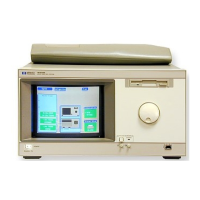CURSTate
Query :TGTctrl:CURSTate<N>?
This command does not obey the truncation rule.
The CURSTate query returns the current state of the specified signal. For
toggle and pulse signals, this will be either 0 or 1. For sequence signals, it
will be between 0 and the last state.
Returned Format
[:TGTctrl:CURSTate<N>] <state><NL>
<N> An integer, 0 through 7, specifying signal.
<state> An integer, 1 through 7, indicating current state.
Example OUTPUT XXX;":TGTCTRL:CURSTATE0?"
DRIVe
Command :TGTctrl:DRIVe<N> {{NORMal|0}|{OPENcllctr|1}}
The DRIVe command sets a signal’s output type. The output type controls
the way in which the line is driven.
<N> An integer, 0 through 7, specifying signal.
Example OUTPUT XXX;":TGTCTRL:DRIVE1 NORMAL"
Query :TGTctrl:DRIVe<N>?
Returned Format [:TGTctrl:DRIVe<N>] <type><NL>
<type> {0|1} 0 indicates normal (TTL); 1 indicates open collector.
TGTctrl Subsystem
CURSTate
14–9

